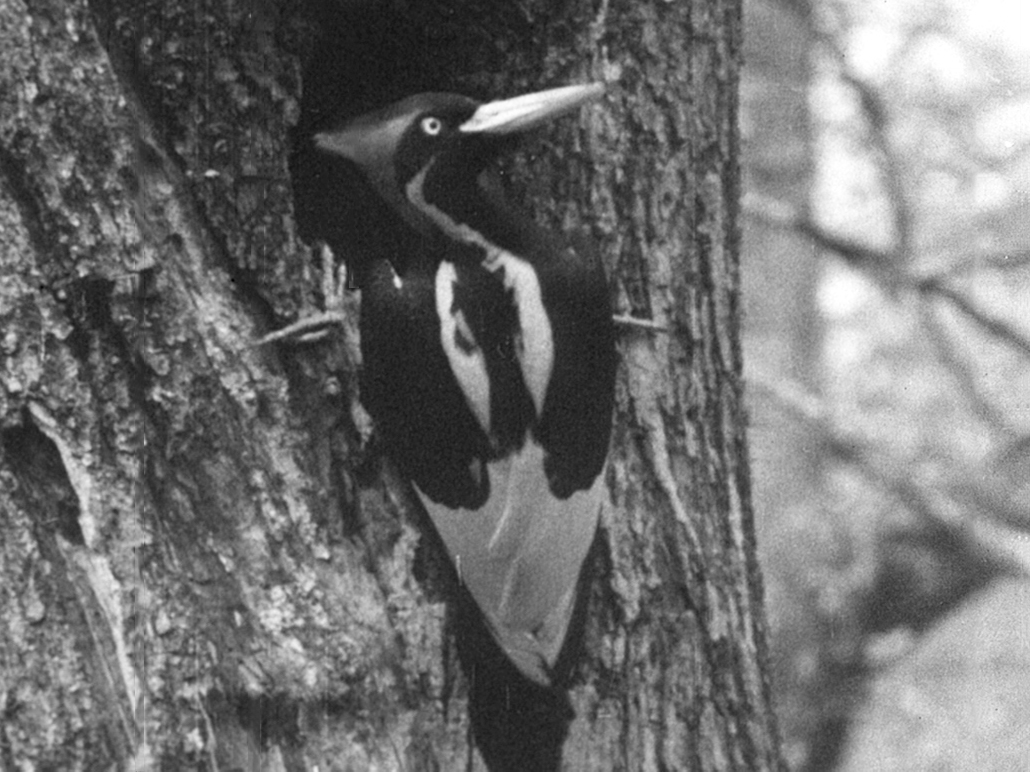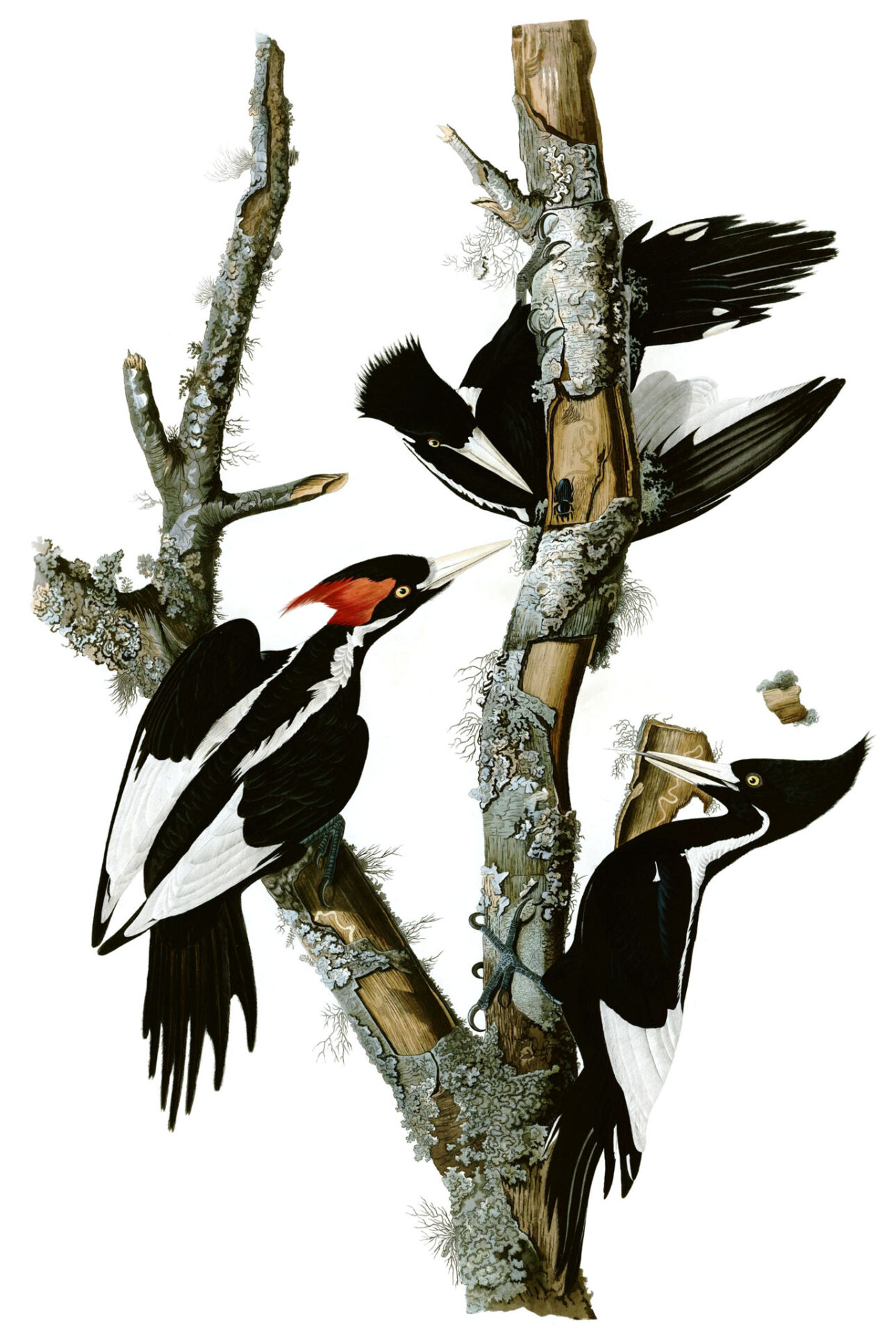Lost
What the ivory-billed woodpecker can teach us about the unknown
Published: August 31, 2023
Last Updated: November 30, 2023

Cornell University Ornithology Lab
A still from a 1935 film by Arthur A. Allen, one of the most recent images of a live ivory-billed woodpecker, shows the specimen at its nest.
When I was asked by 64 Parishes to write this piece, I hesitated. What on earth could I write about the ivory-billed woodpecker that hasn’t already been written? But then I considered the human angle, pondering the questions that the editor posed: Why do people keep hoping, why do they keep thinking that they’ve seen one? What is it about the ongoing mystique of this bird? I decided I was willing to dig in because of my own feelings: personally I do hope that the ivory-billed woodpecker still exists. Because if it does, it would make me feel a tiny bit better about humanity, that we managed to stop destroying habitat and left the species alone just barely enough that it has survived in subterfuge, in spite of the worst angels of our nature.
I accepted the assignment.
Then the tendrils of Louisiana birding expertise curled around me in serendipitous ways.
First, my birding mentor, Van Remsen, shared that he was proposing to teach a course in the Louisiana State University Honors College. He shared his syllabus, which centers the course on a 2021 book entitled Woody’s Last Laugh: How the “Extinct” Ivory-Billed Woodpecker Fools Us into Making 53 Thinking Errors, by biologist J. Christopher Haney. I ordered it immediately. Dr. Haney quickly dispensed with things I thought I knew about the ivory-billed woodpecker: that the bird had a limited diet (wrong, illusory correlation—thinking that things are related when they are not). That the bird went extinct from habitat loss (not necessarily, be careful of congruence bias—overvaluing information that is highly probable). Haney’s book is a “thick” read, but if you are interested in the ivory-billed woodpecker, or the many logic errors that humans routinely invoke, I highly recommend it.
I posit that we need both hope and conviction to be accountable to the plight of the ivory-billed woodpecker and to each other.
Second, my friend Cameron Rutt emailed me to say that my book Adventures of a Louisiana Birder: One Year, Two Wings, Three Hundred Species had just been positively reviewed in Birding magazine, published by the American Birding Association. In our follow-up conversation, we touched on his work as an ornithologist for the American Bird Conservancy, and he mentioned his role as the science lead of the organization’s Search for Lost Birds initiative. I found it remarkable that two LSU-trained ornithologists (Cameron and John Mittermeier, director of the initiative) are at the helm of this worldwide effort to characterize and potentially recover lost bird species. The goal of the initiative is to figure out which birds qualify as lost, gather information about them, and then provide small grants to work with in-country partners to pursue lost species. I asked Cameron if I could interview him about the ivory-billed woodpecker, and he agreed.
Per Cameron, a lost bird is simply any species that has not been adequately photographed, recorded, or genetically sampled in the last ten years. The word “adequately” has some wiggle room, and Cameron clarified that what qualifies as adequate is something equivocal—something that the experts come to consensus on. “The ivory-billed woodpecker is the perfect example of a lost bird,” Cameron noted. “It’s in limbo between persistence and extinction, which is exactly where a lost bird should be.”
I love the lost bird construct, because it enables those who adhere to the charged poles on the topic of the ivory-billed woodpecker’s existence to migrate toward common ground. I believe that calamity and catastrophe reign when humans don’t respect each other. The lost bird construct is a fantastic off-ramp to a different sphere, one where uncertainty can be embraced.
In Cameron’s mind, the “mystique” of the bird comes down to two major factors: a charismatic character and a compelling story. In terms of character, the ivory-billed woodpecker is a distinctive species: large, with white lines that snake under the eyes and down the neck to the back, and a bold white horizontal line formed when the bird folds its mostly white wings against its black back. The widespread pileated woodpecker is somewhat similar to the ivory-billed woodpecker, and because the birds could be easily confused, the possibility of having seen the ivory-billed woodpecker tugs at our imagination. As for the compelling story—Louisianans live in the original stomping grounds of the ivory-billed woodpecker. We might find it in our own backyards (where pileated woodpeckers also happen to be plentiful). Compelling too is the ambiguity, the open end: there was no finality with this species, in contrast to the now extinct passenger pigeon or Carolina parakeet, where people watched the last poor specimen live out its life at a zoo. The story of the ivory-billed woodpecker is the avian equivalent of a soap opera. There’s controversy, warring factions, split houses, name calling, and so on. No wonder that even non-birders have heard of the ivory-billed woodpecker. A quick Google search returns over one million hits, including the recent controversy over the US Fish and Wildlife Service’s plan to declare the species extinct, which was covered by news outlets like CNN, the New York Times, and the Washington Post.
As science lead, part of Cameron’s job is to “data dive” into the archives to establish the last time someone had a well-documented record of a lost species. I thought that the last ivory-billed woodpecker had been spotted in Cuba in 1987. Cameron pointed out that this record wasn’t actually photographed. He said for sure the bird was spotted in Cuba in 1956. But what about the supposed sightings in the Big Woods of Arkansas in 2004–05 and the ensuing 2005 article in Science? According to Cameron, given the lack of consensus among the birding and scientific communities, the documentation would not be considered acceptable—not to mention that the sightings are more than ten years old. Since the Arkansas claims, birders have reported subsequent sightings in Tennessee, Florida, and Louisiana, but no photo or video has emerged that is clear, compelling, and unimpeachable—not since Cuba, 1956. In the United States, the last unimpeachable recorded sighting was Louisiana, 1944.

John James Audubon, Ivory-billed Woodpecker (Campephilus principalis), ca. 1825–26. Mixed media on paper. Library of Congress.
It takes detective work to find information on birds that are poorly known or obscure. A lost bird could be a species described from a specimen in the 1800s but never recorded again, or something described historically that may not be valid. Cameron has compiled information about each lost bird from museum collections, publicly accessible searchable databases, and from citizen science sites like Macaulay Library, Xeno-canto, and iNaturalist. He reports that the volume of information about the ivory-billed woodpecker alone may well rival everything written about the rest of the approximately 130 birds on the list.
Most lost birds are from the tropics, range restricted, and live in specific habitats (e.g., small islands, particular elevations). Only a few are from the United States, including six species from Hawaii, and the Eskimo curlew and Bachman’s warbler in the continental United States. Fans of mystique and drama à la ivory-billed woodpecker might find two other lost bird species of interest: the slender-billed curlew in Europe and the kōkako of the South Island of New Zealand, each with its own compelling story.
The Lost Bird initiative prioritizes funding for research and expeditions to search for lost birds with a relatively strong chance of being found. Since its inception in 2021, the efforts of this group have resulted in confirmation of the persistence of two bird species: the dusky tetraka in Madagascar, lost for 24 years, and the pheasant pigeon of Fergusson Island, Papua New Guinea, lost for 140 years. Cameron said that the ivory-billed woodpecker is not on the high-priority list for funding because it would likely be prohibitively expensive to search for it in the United States.
I come to the close of this article with more knowledge about and appreciation of the ivory-billed woodpecker than when I started, even though we are no closer to knowing if the bird persists. I also gained insight into the strong emotions that swirl around the fate of the ivory-billed woodpecker. Like an iceberg, the subterranean emotional landscape is much larger and more complex than it seems. If I reflect on what’s underneath those feelings, the dominant features seem to be conviction and hope.
At best, these camps disagree. At worst, they hurl insults: not being in touch with reality versus a failure of imagination; lesser birders versus know-it-alls.
The scientific process is unending and can advance in boundless directions. It uses data to ask questions, answer them, and generate a new set of questions. Where the ivory-billed woodpecker is concerned, the Non-Believer camp embraces conviction; they privilege incontrovertible data toward a conclusive answer. The Believer camp embraces hope; they privilege possibility in the open question. I posit that we need both hope and conviction to be accountable to the plight of the ivory-billed woodpecker and to each other. Hope is what drives us to push for greater conservation efforts. Conviction ensures that these efforts are guided with the best available data.
My sources for this article were united in their wish for humans to embrace the middle ground: uncertainty. Cameron summed it up best when it comes to lost birds like the ivory-billed woodpecker: “Accept that there are things we don’t know. Accept that there are things we can’t know. Acting otherwise is to our detriment, and potentially to the detriment of the birds as well.”
For more information on the Lost Birds initiative, visit abcbirds.org/program/lost-birds.
Marybeth Lima is the Cliff and Nancy Spanier Alumni Professor and Chair of the Department of Biological & Agricultural Engineering at Louisiana State University. She is the author of several books, most recently Adventures of a Louisiana Birder: One Year, Two Wings, Three Hundred Species, by Louisiana State University Press (2019). A paperback edition with new afterword was published in 2023.
